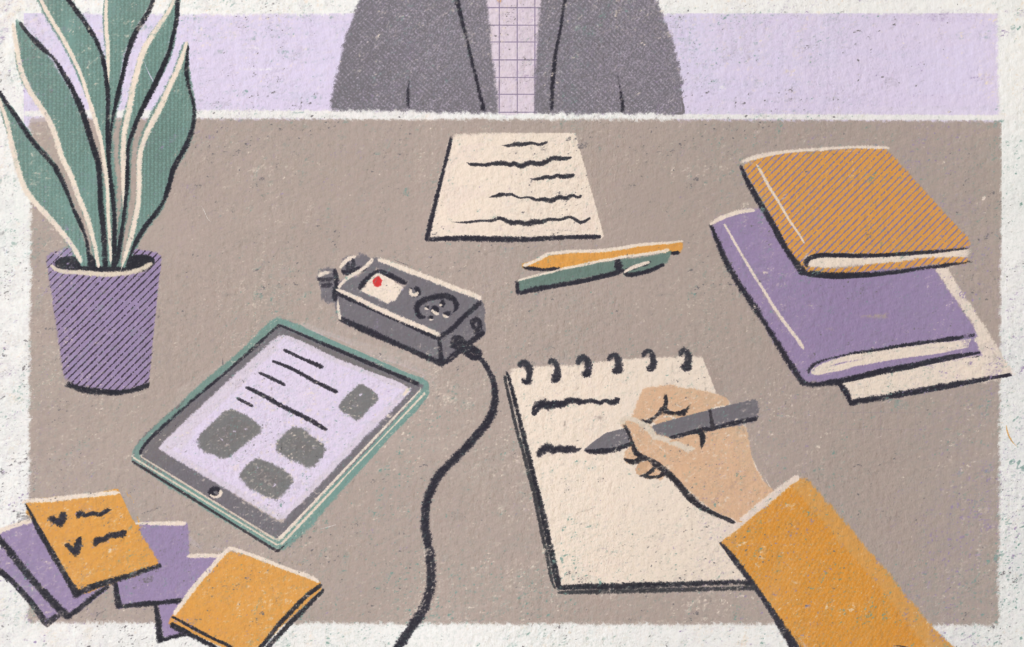
Practical Tips for Breaking Barriers in B2B Research
Doing reliable research is hard. From interviewer biases to understanding the basics of product discovery and scientific methodology, there’s a lot that can be done and there’s no one-size-fits-all solution to designing a decent B2B research strategy. On top of that, you’re always subject to errors coming from sources you have no control over, for example, the bias of the people you want to research.
As if this wasn’t challenging enough when you’re serving other businesses using sensitive information, you have an extra layer of complexity compared to when you’re serving individuals: your research space is much smaller and you have to work harder for each data point.
Let’s take a look at a few tips that can help you extract more meaningful insights from your research.
Focus on problems before jumping into solutions when conducting B2B research
Oftentimes, product and engineering teams are compelled to build solutions under the request of an important stakeholder for problems that weren’t properly defined. As a product manager, you need to leave assumptions behind and fall out of love with solutions you may have already sketched in your mind. Failing to do so may lead you to solve a problem that has no real relevance for your customers, or worse: not solving any relevant problem at all.
First, focus on discovering, exploring, refining, and prioritizing the problems space of your (potential) customers. After having a clear problem definition in hand, you can derive business requirements and bring these to a larger audience, to design a solution.
There’s no silver bullet for exploring the problem space. However, it’s often done with exploratory research, which is best used as the start of your total B2B research plan. In online surveys, open-ended questions could provide you with insightful information, in spite of these kinds of questions being hard to quantify statistically.
To dig deeper into this subject, I suggest reading the insightful “Part IV: The Right Process” of Marty Cagan’s bestseller “Inspired”, and studying Design Thinking a bit.
In-person interviews are also an ally in this exploratory phase, which we’ll take a look at below. At the end of the day, keep in mind – no matter how smart and capable your team is, they won’t be able to solve a problem that they’re not aware of.
In-person interviews with small business owners & managers
In-person interviews have many downsides, like the fact that they’re hard to scale. But an observative and empathetic interviewer would be able to pick on non-verbal clues, clarify questions, and extract valuable information.
Moreover, in-person interviews can also be very useful when your customers are other businesses and you need to ask them for sensitive information about their financials. However, getting a few minutes of business owners’ and managers’ time can be tricky. The points below can help you get the time you need with them:
Be more confident and successful with an “interview kit”:
When conducting B2B research, as you walk into the business you want to interview, you must be presentable and relatable with the people that work there. Dress according to the formality of the business you’re visiting. Also, have a business card ready to be handed out to the people that could get you access to the owner/manager.
If they can’t be interviewed at the moment, make yourself available to come back another time. In that case, having a short letter introducing your company and the research you’re doing could be the only way that some business owners will know you were there. Attach your business card to that letter and ask for the owner’s name and when they’re mostly available.
Finally, be prepared to start right away if they’re ready. This means getting started quickly, which includes setting up the resources you’ll use (e.g. iPads, voice recorders, notebooks, etc).

Use a questionnaire to complement the interviews
You won’t always get the interview you want in the businesses you’ll visit and that’s part of the game. You could work around some of these by providing the potential respondents (in your introduction letter) with a link and QR code for an online questionnaire that they could answer on their own time, and add to the research you’re doing with the interviews.
The major difference between questionnaires and interviews is the presence of an interviewer, and that questionnaires can also help you to scale your research. They’re less expensive (time and money) and subjects feel a greater sense of anonymity. Additionally, you can use the questionnaire to reach a broader audience online.
Break language barriers
Speaking the same language as the business owner plays an important role in gathering the insights you’re looking for in an interview. However, language barriers are a common obstacle, especially in big multicultural metropolitan areas.
In these cases, translating the introduction letter and the questionnaire into other languages commonly spoken by your target demographic could help you reach people that you wouldn’t otherwise. Make sure that you don’t rely only on online translators. Get native speakers to review the translations.
Finally, make sure to include questions about their language proficiency in your interview(s) and questionnaire(s). Understanding the languages the respondents speak could help you to understand their background, increase the accessibility of your service and be an important, competitive advantage in the future.
Be strategic in your approach
Finding interviewees may require some convincing, but having a few tricks up your sleeve can help you achieve this. Visit companies at times that they have low demand, to increase your chances of catching the owners with a few minutes to spare.
Google Maps’ “Popular Times” feature can help you decide what’s the best time for your visit:
Also, exploring the network you, your friends, and your colleagues already have is also a good way to reach business owners and managers and to establish trust.
Finally, some people are more responsive to financial incentives than others. You can reach them by having gift cards (vouchers) for online stores in hand as a “thank you” gift for the interview. It could be also helpful to let respondents know that they could have the opportunity to have early access to your new products and services, with better offers and conditions, if they participate in the interview and/or questionnaire.
Use logic features in your questionnaires
Survey tools have come a long way. For most business cases, it’s not enough to continue using the old forms. Nowadays we have survey tools, that are widely available, that allow us to apply the logic flow that best suits our research without needing to write any code.
In other words, you can take the survey respondent to alternative paths depending on their answers. For the less interesting respondents, this can reduce their response time and, therefore, increase the survey completion rate. For respondents that are more relevant, it can allow you to get more details related to specific answers they gave.
We like to use Typeform as a tool for implementing surveys with custom logic, but it can also be found in other good survey services, such as Survey Monkey.
You’ll learn a lot by just doing B2B research
Your B2B research senses must be tingling by now! Researching can be hard work, but it can also be very interesting and fun. Although planning and studying its various techniques and approaches are super important, a big part of the learnings you’ll read about will only make real sense and be consolidated once you start doing it.
It’s like they say: “Stay hungry, stay foolish”. So get out there and don’t be shy!
